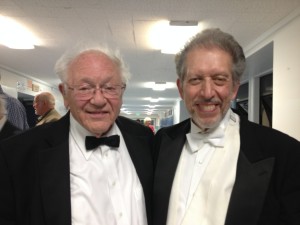
MAESTRO David Ramadanoff, right, announced the retirement of timpanist Len Sperry at the concert Sunday.
Photo by Suzie Peterson
Maestro David Ramadanoff started the program off with a brief introduction to the Handel work, which is actually part of an assemblage of songs commissioned by King George I for a pleasure cruise along the River Thames in 1717. The king wanted to make a big splash, if you’ll pardon the expression, to boost his image in a very public way.
Fifty musicians rode together on a separate barge, performing more than 20 songs while numerous other boats surrounded them, all full of onlookers eager to get a glimpse of the king. George was reportedly so pleased with the music that he had the musicians repeat it more than three times, according to an article that appeared shortly thereafter in The Daily Courant. (Read excerpts from the article at www.aam.co.uk/#/jubilee-pageant/history-of-the-music/water-music.aspx.)
The collection of songs from the royal excursion was later grouped by key into three suites, the first group in F, the third in G. Vallejo’s symphony did the second, D major suite great justice, evoking a clear spirit of regalia and celebration. In keeping with their reputation, the musicians were unified in rhythm, tightly synced, and polished in their execution. The only thing lacking was that unlike the original musicians, the Vallejo players were not at liberty to repeat the performance on the spot.
Instead, they returned for the second half of the concert with an entourage of their own — two virtuosic vocal soloists, along with a combined 120-voice choir.
The story behind Brahms’ German Requiem is even more worthy of space than that of Handel’s Water Music. Brahms composed the piece shortly after his mother died, and according to Maestro Ramadanoff, in the fourth movement, “Wie lieblich sind deine Wohnungen” (“How amiable are thy tabernacles,” from Psalms 84:2), the solo soprano voice seems to clearly represent the voice of Brahms’ mother, and the choir Brahms’ own personal response. There are seven parts to the lengthy opus, beginning with “Selig sind, die da Leid tragen” (“Blessed are those who mourn,” from Matthew 5:4) and ending with the peaceful and reassuring “Selig sind die Toten” (“Blessed are the dead,” from Revelation 14:13).
The piece reflects many firsts — it was the composer’s first hugely popular work, one that propelled him to notoriety; it was an entirely new style of requiem, breaking from the traditional scriptural structure and employing instead passages from several books of the newly available “people’s” Protestant Lutheran Bible; and it extended in theme beyond sorrow to reconciliation and joy. It was a monumental achievement. A critic at the time observed:
“With the first performance of Brahms’s Deutsches Requiem … before an audience of 2,500 in the Bremen Cathedral, there were thousands, who until this time knew practically no music by Brahms … (and were) astounded, attentive, deeply moved,” according to program notes provided by Mary Eichbauer.
Sunday’s trio of choirs, consisting of the choral group Samantics, the Solano Choral Society and the Vallejo Choral Society, performed as a unified whole Sunday, to beautiful effect. At times it was a challenge to make out the words over the instrumental component, but overall the sound was serene and well balanced. Soloist Woody stole the show, wowing the audience with an accomplished blend of emotion, clarity and nuance in each of her parts. Cheak was also flawless in his delivery, if not quite as impassioned.
“A German Requiem” is challenging for a choir, requiring a high level of skill but also stamina to hold up through all seven movements. The voices in Sunday’s performance shone brightly, though by the third movement their sharpness did begin to wane. The composite vocal sound held up emotionally to the end, and, particularly in the heightened passages, the blending of voices with instruments was sublime.
If You Go
The Vallejo Symphony will open the 2014-15 season with “Worlds Away,” featuring works from Mussorgsky, Shostakovich, Ravel and Gershwin, on Sept. 21 at Hogan Auditorium, 850 Rosewood Ave., Vallejo. Tickets are available by contacting the Symphony at 707-643-4441 or at vallejosymphony.org.






The soprano solo is in the 6th, not the 4th movement, and contains the phrase about being comforted as a mother would comfort her child.
“Wie lieblich sind Deine Wohnungen” is the fourth movement and it is choral. I am a little confused by the mentions of these movements in an otherwise well written review.
Thank’s for clearing that up.